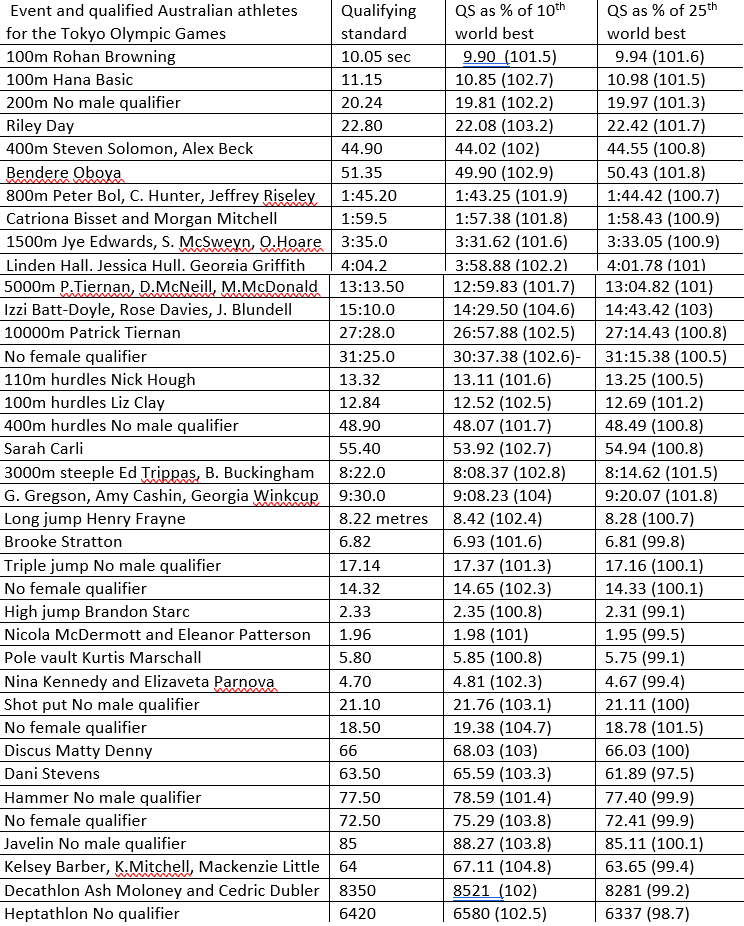With female athletes making up a record 53.5% (254 of 472) of the Australian Olympic Team for the 2021 Tokyo Olympic Games as a proportion of the team (254 of 472), I was interested to see how fair the selection criteria has been for Australia’s athletics team given that the 63 strong athletics team also comprises 35 women and 28 men.
While World Athletics has introduced a new world ranking system for qualification to the Tokyo, with rankings based on the average of the best five results for the athlete over the qualifying period (roughly from early 2019 to 29 June 2021, I assess selection fairness by comparing the qualifying times for men and women against the best world performers of previous years.
The following table, which focuses on the individual track and field events, compares the qualifying standards (QS) set by World Athletics against the best standards achieved by world athletes from 2016 to 2018.
Advertisement
Column 1 lists the qualified Australian athletes and events.
Column 2 lists the qualifying standard set by World Athletics.
Column 3 lists the 10th best world performance from 2016 to 2018 with the qualifying standard (in brackets) listed as a percentage of the performance.
Column 4 lists the 25th best world performance from 2016 to 2018 with the qualifying standard (in brackets) listed as a percentage of the performance.
A percentage above 100% means that the qualifying standard is inferior to the 10th and 25th ranking, while a percentage below 100% means that the qualifying standard is superior.
While the running events tend to have a higher percentage than the field events when compared to the 25th best world performance in column 4, this is because many more athletes are required for running events which have heats, semis and finals in most events, whereas field events are much more limited in number.
Advertisement
Hence, some of the field events will have a lower figure than 100% as it is even tougher than the 25th ranked performance from 2016 to 2018 and helps explain why Australians did not qualify in many throwing events.
The following table excludes the marathon (6 competitors) and walking events (seven competitors), and the four additional female athletes selected for Australia’s only relay team (4x400m),

If we compare qualification standards against the 25th best world performance from 2016 to 2018, there is little difference between the men and women in 16 of the 19 individual events with less than 1% separating them. In 12 of the events there was only a maximum 0.5% difference.
Six of the 19 events had a tougher standard for the women, and nine had a slightly tougher standard for men.
The 5000m is the only event where there appears to be a significant difference that favours the females, yet that event did not prevent the maximum three qualifiers for both genders.
The same is true when comparing qualification standards against the 10th ranked global athlete from 2016 to 2018, although the difference between the genders is slightly above 1% in more events.
While not all selected Australians met the qualifying standard listed in the table since 2019 (five males and eight females), most of Australia’s selected athletes did indeed qualify or were very close to the listed qualifying standard.
The overall tough criteria also means that Australia has no male competitor in six of the individual events, while there are no females in five events.
In accordance to the information presented in the above table, Australia’s track and field team is indeed selected on a fair basis.
While this article cannot speak for the other OG sports, it does show that the criteria for selecting men and women for Australia’s athletics team is quite fair with similar qualifying standards for both men and women.
It simply does not matter if any Australian team has a higher proportion of females if they that are the ones that most often meet the qualifying standard.
After all, there is nothing like a bit of competition.